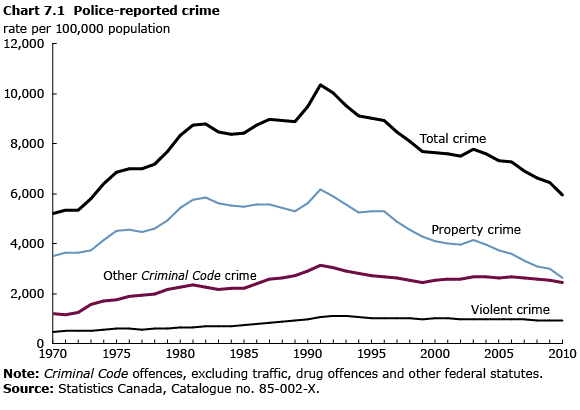Crime and justice
Archived Content
Information identified as archived is provided for reference, research or recordkeeping purposes. It is not subject to the Government of Canada Web Standards and has not been altered or updated since it was archived. Please "contact us" to request a format other than those available.
Related information
The police-reported crime rate, which measures the volume of crime, continued its long-term downward trend in 2010, declining 5% from 2009. At the same time, the Crime Severity Index (CSI), which measures the seriousness of crime, fell 6%.
Similarly, the overall youth crime rate and its severity have been generally declining for the past decade. However, violent crimes committed by young people have increased in severity. The youth violent crime severity index rose 5% from 2000 to 2010.
Both the volume and severity of police reported crime declined or remained stable across most of Canada in 2010. The largest declines occurred in Alberta and British Columbia. The only jurisdictions where both the volume and severity of crime grew were Newfoundland and Labrador, the Northwest Territories and Nunavut. Similar to previous years, police-reported crime rates and crime severity in 2010 were substantially higher in the North.
Police-reported crime lowest since early 1970s
The national crime rate has been falling steadily for the past 20 years and is now at its lowest level since 1973. The Crime Severity Index has reached its lowest point nationally (82.7) since 1998, the first year for which CSI data are available. (The crime rate excludes Criminal Code traffic offences, drug offences and other federal statute offences, as well as provincial statute offences.)
Police reported nearly 2.1 million Criminal Code incidents (excluding traffic) in 2010, about 77,000 fewer than in 2009. Four property crimes accounted for most of the decline: theft under $5,000, mischief, motor vehicle theft, and break and enter.
Many other offences also decreased, including homicide, attempted murder, serious assaults and robbery. However, some offences did increase, including sexual assault, use/discharge of a firearm, criminal harassment and child pornography. The rate of drug offences increased 10% in 2010, continuing a general upward trend that began in the early 1990s.
Police reported just over 437,000 violent incidents in 2010, about 7,200 fewer than in the previous year. Violent crimes accounted for just over 1 in 5 offences. The violent CSI declined for a fourth consecutive year. The national rate of 1.62 homicides per 100,000 people in 2010 was the lowest since 1966. The number of attempted murders also declined, falling to the lowest rate in over 30 years.
Similar to previous years, most crimes (79%) reported by police in 2010 were non-violent. Theft under $5,000, mischief and break-ins accounted for close to two-thirds of the almost 1.7 million non-violent offences, as the non-violent CSI fell for a seventh consecutive year.
In 2010, the rate of break-ins continued its steady decline since the early 1990s peak, dropping 6% from 2009. The rate of motor vehicles reported stolen dropped 15%, continuing the downtrend seen since the mid-1990s. The national rate of impaired driving fell 6% and has generally been declining since 1981.
Police strength and spending
Police strength—as measured by police officers per capita—increased 2% in 2010 to 203 officers for every 100,000 people, its highest level since 1981. Saskatchewan and Manitoba, the provinces with the highest CSI values, also have the highest police strengths.
As of May 15, 2010, there were 69,300 police officers in Canada, up by 2,000 from 2009, the sixth consecutive annual increase. About 1 in 5 officers were women, compared with 1 in 5 in 1990.
International comparisons show that police strength in Canada in 2010 was 8% lower than in Australia (222 per 100,000 people), 11% lower than in England and Wales (229) and 17% lower than in the United States (244).
As of May 15, 2010, there were just over 27,000 civilians employed in Canadian police services, for a rate of 2.5 police officers per civilian employee. That ratio has been declining steadily since 1962, when there were 4.6 officers for every civilian employee. In 2010, most civilian policing personnel provided clerical support (39%), management (29%) or communications and dispatch (13%).
Total spending on policing exceeded $12 billion in 2009. After adjusting for inflation, police expenditures rose by 7.3%, the 13th consecutive annual increase.
- Date modified:

